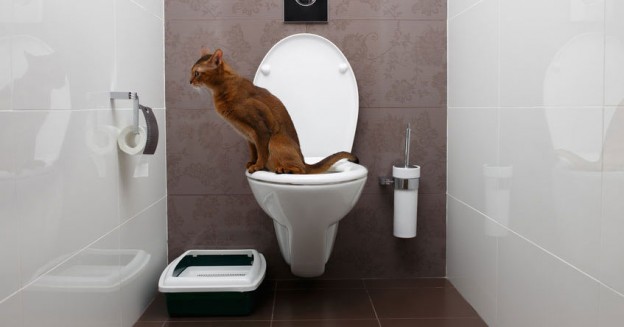We've found the article pertaining to How to Dispose of Cat Poop and Litter Without Plastic Bags listed below on the net and thought it made perfect sense to relate it with you over here.

Introduction
As pet cat proprietors, it's important to be mindful of just how we throw away our feline pals' waste. While it might appear practical to purge cat poop down the commode, this practice can have destructive effects for both the environment and human health and wellness.
Alternatives to Flushing
Fortunately, there are much safer and extra responsible methods to get rid of pet cat poop. Consider the complying with options:
1. Scoop and Dispose in Trash
One of the most usual method of getting rid of pet cat poop is to scoop it right into an eco-friendly bag and toss it in the garbage. Be sure to use a committed clutter scoop and get rid of the waste immediately.
2. Usage Biodegradable Litter
Opt for naturally degradable feline trash made from products such as corn or wheat. These litters are eco-friendly and can be securely taken care of in the garbage.
3. Hide in the Yard
If you have a lawn, think about burying cat waste in a designated area far from veggie gardens and water sources. Make certain to dig deep sufficient to avoid contamination of groundwater.
4. Install a Pet Waste Disposal System
Buy a family pet waste disposal system specifically made for feline waste. These systems use enzymes to break down the waste, lowering odor and ecological effect.
Health Risks
In addition to ecological worries, purging feline waste can additionally position wellness risks to people. Feline feces might have Toxoplasma gondii, a parasite that can trigger toxoplasmosis-- a possibly extreme illness, particularly for expecting ladies and people with damaged body immune systems.
Ecological Impact
Flushing cat poop introduces damaging microorganisms and bloodsuckers right into the water system, presenting a substantial danger to water ecological communities. These impurities can adversely affect marine life and compromise water quality.
Conclusion
Liable family pet ownership extends past giving food and sanctuary-- it also entails correct waste administration. By refraining from purging feline poop down the toilet and selecting alternate disposal methods, we can lessen our environmental impact and secure human health and wellness.
Why You Should NEVER Flush Cat Poop (and/or Litter) Down Your Toilet
The Problem with Litter
The main function of litter is to solidify and adhere to your cat’s waste. While this makes litter excellent for collecting cat poop and urine, it’s also the exact property that makes it a nightmare when flushed down the toilet.
Cat litter can and will clog pipes. There is non-clumping litter, but it’s still quite heavy and can build up in pipes. This is true even of supposed “flushable litter.”
The problems only compound when the litter is already clumped into cat waste. Toilet paper is among the more flushable things, and even too much of that will clog a toilet.
The Problem with Cat Poop
Sewers and septic systems are designed with human waste in mind. The microbes that help break down human waste don’t work on cat waste. Additionally, cat poop plays host to the parasite Toxoplasma gondii.
When flushed, this parasite can enter the environment in places it was never meant to, posing a risk to pregnant women, their unborn children, and other people with compromised immune systems. While it might not seem possible, flushing cat poop can indeed introduce this parasite to the public water supply.
These reasons are why, even if you’ve trained your cat to go on the toilet and flush, which is possible, it’s still not a good idea. Also, pregnant women and the immunocompromised shouldn’t change litter, either.
How to Handle Litter
The best way to handle litter is to simply put it in a plastic bag and place it in the trash. Avoiding environmental risks and possible plumbing damage is worth the extra effort.
You can also invest in devices that seal away your cat’s waste in a separate compartment, so you don’t have to change the litter nearly as often. They’re also safer for pet owners because they limit the possibility of Toxoplasma gondii exposure.
Disposing of litter the old-fashioned way will ensure you won’t have to worry about any issues that flushing the waste can potentially cause.
Take Care of Clogged Pipes with Stephens Plumbing, Heating & Air Conditioning
The reasons you should never flush cat poop down your toilet are numerous, but sometimes the inevitable happens despite your best efforts.
Stephens Plumbing, Heating & Air Conditioning is ready to help if you’re experiencing litter-blocked plumbing. Whether you need us in an emergency or want to schedule regular maintenance, we’re here for you.
https://www.stephensplumbing.net/bathroom-plumbing/never-flush-cat-poop-down-your-toilet/

Do you really like reading up on How to Dispose of Cat Poop and Litter Without Plastic Bags? Put a comment below. We'd be delighted to know your thinking about this write-up. Hoping that you visit us again in the near future. Sharing is nice. Helping people is fun. Thanks a bunch for your time. Come back soon.
Get Started
Comments on “Prevent Clogs and Damage: Don't Flush Cat Poop Down Your Toilet - Expert Recommendations”